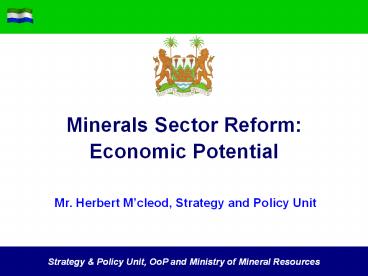Minerals Sector Reform: Economic Potential - PowerPoint PPT Presentation
1 / 10
Title:
Minerals Sector Reform: Economic Potential
Description:
Minerals Sector Reform: Economic Potential Mr. Herbert M cleod, Strategy and Policy Unit Strategy & Policy Unit, OoP and Ministry of Mineral Resources Strategy ... – PowerPoint PPT presentation
Number of Views:23
Avg rating:3.0/5.0
Title: Minerals Sector Reform: Economic Potential
1
Minerals Sector Reform Economic Potential
- Mr. Herbert Mcleod, Strategy and Policy Unit
2
Mining sector growth outlook
- Following data prepared by ASI using recent World
Bank and IMF assessments of Sierra Leonean mining
sector and economy - Successful realisation of large scale mineral
potential in Sierra Leone can yield - 2 rutile mines (330,000 tons/annum)
- 2 bauxite mines (2.5m tons/annum)
- 2 kimberlite mines (450,000 carats/annum)
- 2 gold mines (300,000 oz/ annum)
- One each of the rutile, bauxite and kimberlite
mines are already in operation. Remaining
projects are assumed to come on stream in
2010-2013
3
Mining sector growth outlook (2)
- Annual production growth after 2012 is assumed to
be - Rutile 4 per annum - Diamonds 4 per annum
- Bauxite 7 per annum - Gold 10 per annum
- These long-term growth forecasts draw on
experience in comparable countries (Ghana,
Tanzania, Mali) and Sierra Leones
well-established geological prospects - Mineral price forecasts are based on the 2006 IMF
review of the Sierra Leonean mining tax regime
(constant 2007 prices) - Rutile 450 per tonne - Diamonds 225 per
carat - Bauxite 26 per tonne - Gold 500 per ounce
4
Impact on economic growth
Base Case Scenario
- Mining sector can serve as an engine of economic
growth - Expect an extra GDP growth of 1.2 per year if
supported by a growing mining sector
Extra US 100 per capita
- With new investment in the mining sector, GDP per
capita can be 6 higher in five years than it
would be without mining growth, and 17 higher by
2020
5
Impact on exports
- Mining sector currently generates well over 90
of export income - This will decline to less than 75 within a
decade in the absence of new mineral sector
investments
- With new investments, however, the value of
mineral exports could rise from 230 million
today to in excess of 1.2 billion by 2020 - Mineral exports per capita can be expected to
more than double within four years and rise from
34 per capita today to 170 by 2020
6
Transformations in Mining
- Ghana (production)
- Papua New Guinea (expl.)
- A long decline prompted, Minerals Commission, and
new mining laws enacted in 1986 - new gold mine in 40 years within 2 years of
reforms - Over 20 annual increase in Gold and bauxite
production following reforms - Gold from 280,000 oz to 1.9m oz a year
- Bauxite from 120,000t to 530,000t a year
- Foreign investment since then has r has exceeded
5 billion - Mineral export increased from 108 million in
1985 to over 2 billion today
- Political instability led to withdrawal by
companies and fall in Exploration expenditure
from 83 million in 1989 to only 8 million in
2000 - The Mining Department replaced in 2001 with a
Mineral Resources Authority, extensive airborne
geological surveys launched, and new fiscal terms
introduced - Exploration licence applications increased from 5
in 2000 to 132 by 2006, and exploration
expenditures are rapidly growing
7
Impact on Govt revenues
- Mining sector contributed only 5 of Sierra
Leones Govt revenue in 2006 (around Le 30bn),
around 5 of the value of mineral exports - Ghanas revenues from mining represent around 5
of the export value of its minerals. - Tanzania, which has recently become a significant
gold producer, secures around 10
8
Impact on Govt revenues (2)
- With a well-administered and balanced fiscal
regime, it is reasonable to expect that Sierra
Leone could retain around 7 of the value of
mineral exports as Government revenue through - Increased average royalty rates, new projects
should pay the legislated royalty rates, as
compared to the concessional rates made available
to rehabilitated mines - Greater mine profitability, as existing mines
mature and costs are fully recouped - Significant indirect taxes derived from
large-scale mines (salary taxes, import and
excise duties, service charges etc) - Retaining 7 of the mineral export value, could
see Govt revenue from mining increase to over Le
100bn annually within four years and over Le
200bn annually by 2020 (in real terms)
9
Impact on poverty/growth
- The contribution of the sector should be judged
not only by their economic impact, but also by
the wider impact on society - By 2011, some 190,000 people could be lifted out
of poverty due to mining industry growth. This
number could rise to 900,000 by 2020 - These figures are derived from analyses that are
heavily dependent on the sector being considered
mainly for its revenue streams
10
Impact on Poverty (3)
- The increases in Govt revenue from the mining
sector could fund - By 2011
- A doubling of the Govt direct financing
component of the Development Budget, therefore
enabling increased leadership by the Government
relative to its donor partners, in the countrys
development or - The employment of an additional 30,000 health
care professionals - By 2020
- The employment of 50,000 new full-time school
teachers or - A more than doubling of the current rate of
investment in the rehabilitation and maintenance
of the national road network































